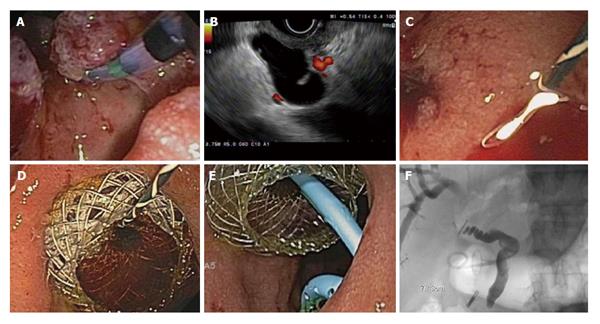Copyright
©The Author(s) 2016.
World J Gastrointest Endosc. Apr 10, 2016; 8(7): 319-329
Published online Apr 10, 2016. doi: 10.4253/wjge.v8.i7.319
Published online Apr 10, 2016. doi: 10.4253/wjge.v8.i7.319
Figure 2 A 84 years old male with duodenal adenocarcinoma causing biliary obstruction underwent endoscopic ultrasound-guided choledochoduodenostomy following unsuccessful endoscopic retrograde cholangiopancreatography.
A: Tumor involving the major papilla; B: Endoscopic ultrasound-guided puncture of the common bile duct through the duodenum with a 19-gauge needle; C: Guidewire insertion and balloon dilation of a choledochoduodenal fistula; D: Followed by the placement of a 10 mm × 10 mm lumen-apposing metal stent to create a choledochoduodenostomy; E and F: Endoscopic (E) and flouroscopic (F) view after the placement of a 7 Fr × 3 cm double pigtail stent into the common hepatic duct.
- Citation: Oh SY, Irani S, Kozarek RA. What are the current and potential future roles for endoscopic ultrasound in the treatment of pancreatic cancer? World J Gastrointest Endosc 2016; 8(7): 319-329
- URL: https://www.wjgnet.com/1948-5190/full/v8/i7/319.htm
- DOI: https://dx.doi.org/10.4253/wjge.v8.i7.319









